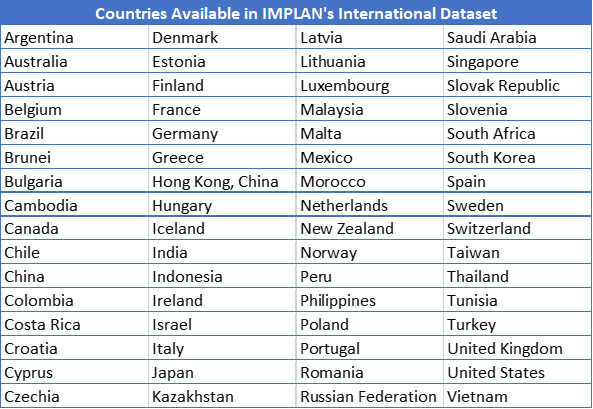posted by Kade Grafel on Monday, April 3, 2023
The team at IMPLAN have been hard at work over the past year or so. The IMPLAN modeling system continues to be improved and expanded, and there have been several exciting recent developments.
First, the IMPLAN team recently released the Canadian Provincial Package, which covers all provinces and territories within Canada. These provincial models are primarily built using data from Statistics Canada, which is Canada’s equivalent of U.S. Census data. Within these models, all economic activity is broken down into one of 235 industries. While not quite as detailed as the standard U.S. models that use 546 industries, this still provides a very useful level of granularity. Notably, 27 of these industries represent agricultural activities. Canadian Data is currently available for the years 2017 through 2019.
That’s not the only new data offering, though. The IMPLAN team also recently released a series of international models. These models were built primarily using the country-specific input-output tables published by the OECD and supplemented with data from other sources. While this data is only broken down into 37 industries due to data limitations, 64 country-level models are currently available. A full list of available countries is shown in the following table. The OECD data underlying these models is released every three years. These models are currently available for the 2015 data year, and the 2018 models are expected to be released soon.

Finally, the IMPLAN API (Application Programming Interface) has recently been made available for IMPLAN users. The API allows users to work with IMPLAN models directly through either a spreadsheet program (such as Microsoft Excel or Google Sheets) or a programming language (such as Python or R). While the API does not necessarily add any new functionalities to what can be done using the normal IMPLAN web interface, it does make large-scale analyses (such as a contribution study looking at every county in the U.S., for example) much quicker and easier. Other activities can also be made easier with the IMPLAN API, such as conducting exploratory analysis or building custom regions.
In conclusion, the IMPLAN modeling system continues to expand and improve. The IMPLAN API makes large projects more feasible, and IMPLAN now has several different data products allowing for economic impact and contribution analyses to be conducted internationally.